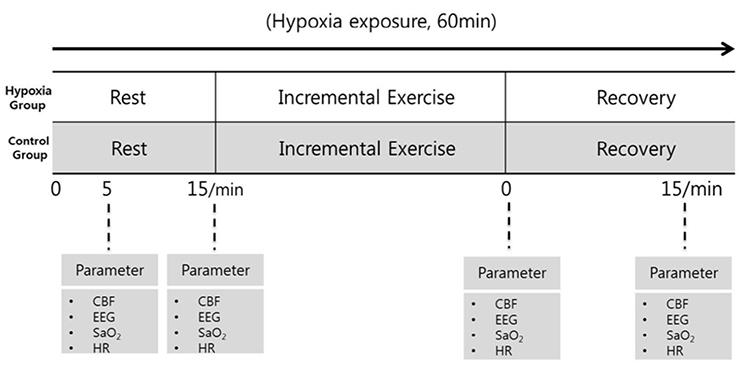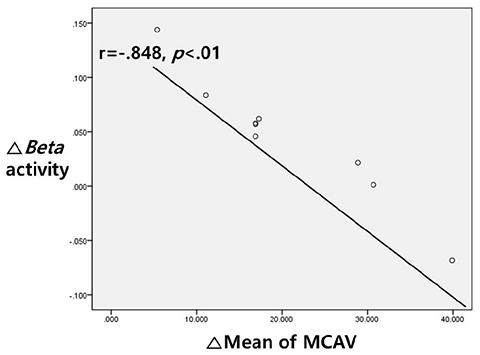Korean J Health Promot.
2019 Mar;19(1):59-67. 10.15384/kjhp.2019.19.1.59.
Effects of Bicycle Ergometer Exercise on Cerebral Blood Flow Velocity and Electroencephalogram Response in Normoxia and Hypoxia
- Affiliations
-
- 1Department of Sports Science, Hannam University, Daejeon, Korea. jig1229@hanmail.net
- 2Department of Sports Rehabilitation, Woosong University, Daejeon, Korea.
- KMID: 2442659
- DOI: http://doi.org/10.15384/kjhp.2019.19.1.59
Abstract
- BACKGROUND
The cerebral blood flow velocity (CBFV) has been known to increase in response to acute hypoxia. However, how CBFV might respond to exercise in hypoxic conditions and be associated with electroencephalogram (EEG) remains unclear. The purpose of this study was to evaluate the effect of exercise in hypoxic conditions corresponding to altitudes of 4,000 m on CBFV and EEG.
METHODS
In a randomized, double-blind, balanced crossover study, ten healthy volunteers (19.8±0.4 years) were asked to perform the incremental bicycle ergometer exercise twice in hypoxic and control (sea level) conditions with a 1-week interval, respectively. Exercise intensity was set initially at 50 W and increased by 25 W every 2 minutes to 125 W. Acute normobaric hypoxic condition was maintained for 45 minutes using low oxygen gas mixture. CBFV in the middle cerebral artery (MCA) and EEG were measured at rest 5 minutes, rest 15 minutes, immediately after exercise, and 15 minutes recovery using transcranial-Doppler sonography and EEG signal was recorded from 6 scalp sites leading to analysis of alpha and beta wave relative activities. All data were analyzed using two-way repeated-measures analysis of variance and Pearson's correlation.
RESULTS
CBFV in the MCA in the hypoxic condition was significantly higher than that in the control condition at rest 5 minutes (83±9 vs. 69±9 cm/s, P<0.01), rest 15 minutes (87±8 vs. 67±7 cm/s, P<0.001), immediately after exercise (112±9 vs. 97±9 cm/s, P<0.01), and 15 minutes recovery (91±11 vs. 74±7 cm/s, P<0.01). However, no significant correlation was found between the changes of CBFV and EEG wave activities.
CONCLUSIONS
These results suggest that the drastic change of CBFV observed during exercise with hypoxia might appear independently with EEG wave activities.
MeSH Terms
Figure
Reference
-
1. Secher NH, Seifert T, Van Lieshout JJ. Cerebral blood flow and metabolism during exercise: implications for fatigue. J Appl Physiol. 2008; 104(1):306–314.
Article2. Ogoh S, Ainslie PN. Cerebral blood flow during exercise: mechanisms of regulation. J Appl Physiol. 2009; 107(5):1370–1380.
Article3. Schneider S, Strüder HK. Monitoring effects of acute hypoxia on brain cortical activity by using electromagnetic tomography. Behav Brain Res. 2009; 197(2):476–480.
Article4. Feddersen B, Neupane P, Thanbichler F, Hadolt I, Sattelmeyer V, Pfefferkorn T, et al. Regional differences in the cerebral blood flow velocity response to hypobaric hypoxia at high altitudes. J Cereb Blood Flow Metab. 2015; 35(11):1846–1851.
Article5. Imray CH, Myers SD, Pattinson KT, Bradwell AR, Chan CW, Harris S, et al. Effect of exercise on cerebral perfusion in humans at high altitude. J Appl Physiol. 2005; 99(2):699–706.
Article6. Gupta AK, Menon DK, Czosnyka M, Smielewski P, Jones JG. Thresholds for hypoxic cerebral vasodilation in volunteers. Anesth Analg. 1997; 85(4):817–820.
Article7. Ainslie PN, Barach A, Murrell C, Hamlin M, Hellemans J, Ogoh S. Alterations in cerebral autoregulation and cerebral blood flow velocity during acute hypoxia: rest and exercise. Am J Physiol Heart Circ Physiol. 2007; 292(2):H976–H983.
Article8. Ozaki H, Watanabe S, Suzuki H. Topographic EEG changes due to hypobaric hypoxia at simulated high altitude. Electroencephalogr Clin Neurophysiol. 1995; 94(5):349–356.
Article9. Martin D, Powers S, Cicale M, Collop N, Huang D, Criswell D. Validity of pulse oximetry during exercise in elite endurance athletes. J Appl Physiol. 1992; 72(2):455–488.
Article10. Moraine JJ, Lamotte M, Berré J, Niset G. Leduc A, Naeijel R. Relationship of middle cerebral artery blood flow velocity to intensity during dynamic exercise in normal subjects. Eur J Appl Physiol Occup Physiol. 1993; 67(1):35–38.11. Ogoh S, Brothers RM, Barnes Q, Eubank WL, Hawkins MN, Purkayastha S, et al. The effect of changes in cardiac output on middle cerebral artery mean blood velocity at rest and during exercise. J Physiol. 2005; 569(Pt 2):697–704.
Article12. Huang SY, Tawney KW, Bender PR, Groves BM, McCullough RE, McCullough RG, et al. Internal carotid flow velocity with exercise before and after acclimatization to 4,300 m. J Appl Physiol. 1991; 71(4):1469–1476.
Article13. Yamamoto Y, Hoshika Y, Miyashita M. Effects of acute exposure to simulated altitude on heart rate variability during exercise. J Appl Physiol. 1996; 81(3):1223–1229.
Article14. Patel S, Huang DL, Sagher O. Sympathetic mechanisms in cerebral blood flow alterations induced by spinal cord stimulation. J Neurosurg. 2003; 99(4):754–761.
Article15. Kraaier V, Van Huffelen AC, Wieneke GH. Quantitative EEG changes due to hypobaric hypoxia in normal subjects. Electroencephalogr Clin Neurophysiol. 1988; 69(4):303–312.
Article16. Moraes H, Ferreira C, Deslandes A, Cagy M, Pompeu F, Ribeiro P, et al. Beta and alpha electroencephalographic activity changes after acute exercise. Arq Neuropsiquiatr. 2007; 65(3A):637–641.
Article
- Full Text Links
- Actions
-
Cited
- CITED
-
- Close
- Share
- Similar articles
-
- The Effect of Aerobic Exercise on the Cardiovascular System in the Early Stoke Patients
- Selection of Aerobic Exercise Intensity Using Heart Rate Reserve in Stroke Patients
- Longitudinal change of cerebral blood flow velocity in neonates with the doppler technique
- The Selection of Exercise Stress Test in Hemiplegic Patients
- The Relationship between Umbilical-Cerebral Doppler Ratio and Umbilical Artery Gas Analysis



